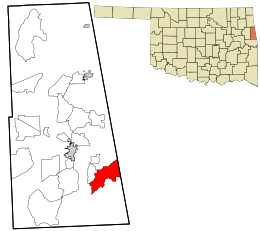Bell, Oklahoma facts for kids
Quick facts for kids
Bell
|
|
|---|---|
|
census-designated place (CDP)
|
|

Location within Adair County and the state of Oklahoma
|
|
| Country | United States |
| State | Oklahoma |
| County | Adair |
| Area | |
| • Total | 4.70 sq mi (12.18 km2) |
| • Land | 4.70 sq mi (12.18 km2) |
| • Water | 0.00 sq mi (0.01 km2) |
| Elevation | 948 ft (289 m) |
| Population
(2020)
|
|
| • Total | 191 |
| • Density | 40.63/sq mi (15.69/km2) |
| Time zone | UTC-6 (Central (CST)) |
| • Summer (DST) | UTC-5 (CST) |
| FIPS code | 40-05090 |
| GNIS feature ID | 2407825 |
Bell is a small community located in Adair County, Oklahoma, United States. It is known as a census-designated place (CDP), which means it's an area defined by the U.S. Census Bureau for statistical purposes.
In 2010, the population of Bell was 535 people. This was a slight decrease from the 602 people who lived there in 2000. By 2020, the population was 191.
Contents
Where is Bell Located?
Bell covers an area of about 4.70 square miles (or 12.18 square kilometers). All of this area is land, with no large bodies of water. It is located in the eastern part of Oklahoma.
Who Lives in Bell?
| Historical population | |||
|---|---|---|---|
| Census | Pop. | %± | |
| 2020 | 191 | — | |
| U.S. Decennial Census | |||
Let's look at the people living in Bell based on the 2000 census. There were 602 people living there at that time.
Population Makeup in 2000
- About 35.71% of the people were White.
- A large part, 57.81%, were Native American.
- A small number were African American (0.33%) or from other races (0.17%).
- About 5.98% of the people were from two or more races.
- Less than 1% (0.66%) of the population was Hispanic or Latino.
Households and Families
In 2000, there were 181 households in Bell. A household is a group of people living together.
- About 38.1% of these households had children under 18 living with them.
- Most households (63.5%) were married couples living together.
- About 13.8% had a female head of the household with no husband present.
- Around 15.5% were non-family households.
- About 13.8% of all households had someone living alone.
- About 7.2% of households had someone aged 65 or older living alone.
The average household had 3.33 people, and the average family had 3.69 people.
Age Distribution
The population in Bell was spread out across different age groups:
- 31.6% were under 18 years old.
- 11.8% were between 18 and 24.
- 26.9% were between 25 and 44.
- 18.6% were between 45 and 64.
- 11.1% were 65 years or older.
The average age of people in Bell was 30 years. For every 100 females, there were about 102 males.
Income and Poverty
In 2000, the average income for a household in Bell was $20,000 per year. For families, the average income was $23,482.
- Males generally earned more, with a median income of $20,450.
- Females had a median income of $14,750.
- The average income per person in Bell was $8,753.
Sadly, about 30.5% of families and 35.1% of the total population lived below the poverty line. This included 44.8% of children under 18 and 37.1% of people aged 65 or over.
Bell's Waterline Project
In the early 1980s, a very important project happened in Bell. Many residents did not have indoor running water. The Cherokee Nation, led by Wilma Mankiller, decided to help. Wilma Mankiller later became the principal chief of the Cherokee Nation.
Building the Waterline
Wilma Mankiller and her colleague, Charlie Soap, planned to build a 16-mile waterline to Bell. The Cherokee Nation provided the equipment and technical help. The amazing part was that the people of Bell volunteered their time and labor to build most of the waterline themselves.
Impact of the Project
This project gained a lot of attention because it showed how a community could work together. It also helped launch Wilma Mankiller's career as a leader. A movie called The Cherokee Word for Water was made in 2013 about this inspiring project.
School Changes in Bell
In June 2010, the school district in Bell, which had been around for 200 years, faced a big change. The Oklahoma state Board of Education found some financial problems during an audit. Because of this, the state decided the school district needed to close.
School Consolidation
The Bell school district taught students from Kindergarten through eighth grade. About 97% of the students were Cherokee children. After the closure, these students were moved to two other school districts: Stilwell and Belfonte. These districts now manage the education and finances for the former Bell students. The old Bell school building is still used, even though it's no longer its own district.
See also
 In Spanish: Bell (Oklahoma) para niños
In Spanish: Bell (Oklahoma) para niños

